#greek vegetable exports
Text
Discovering the world
Lebanon 🇱🇧
Basic facts
Official name: الجمهورية اللبنانية (al-Jumhūrīyah al-Lubnānīyah) (Republic of Lebanon)
Capital city: Beirut
Population: 5.3 million (2023)
Demonym: Lebanese
Type of government: unitary parliamentary republic
Head of state: vacant (President)
Head of government: Najib Mikati (Prime Minister)
Gross domestic product (purchasing power parity): $78.23 billion (2022)
Gini coefficient of wealth inequality: 31.8% (medium) (2011)
Human Development Index: 0.723 (high) (2022)
Currency: pound (LBP)
Fun fact: It hosts the highest number of refugees per capita and per square kilometer.
Etymology
The country’s name comes from Mount Lebanon, whose name derives from the Phoenician root lbn, meaning “white”.
Geography
Lebanon is located in West Asia and borders Syria to the north and east, Israel to the south, and the Mediterranean Sea to the west.

There are two main climates: Mediterranean-influenced humid continental in the center and east and hot-summer Mediterranean in the rest. Temperatures range from 11 °C (51.8 °F) in winter to 30 °C (86 °F) in summer. The average annual temperature is 20.9 °C (69.6 °F).

The country is divided into nine governorates (muḥāfaẓāt), which are further divided into twenty-five districts (aqdyah). The largest cities in Lebanon are Beirut, Tripoli, Jounieh, Zahlé, and Sidon.
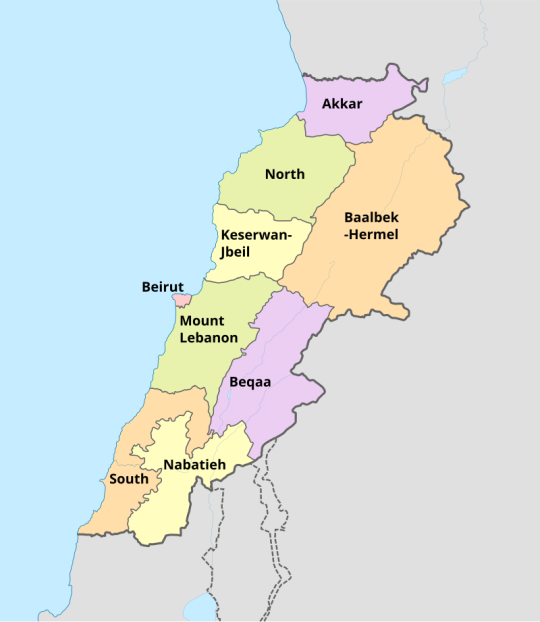
History
2500-64 BCE: Phoenicia
1650-1180 BCE: Hittite Empire
1550-1069 BCE: New Kingdom of Egypt
550-332 BCE: Achaemenid Empire
332-64 BCE: Seleucid Empire
64 BCE-394 CE: Roman Empire
394-635: Byzantine Empire
619-629 CE: Sasanian Empire
636-661: Rashidun Caliphate
661-750: Umayyad Caliphate
750-1517: Abbasid Caliphate
1099-1291: Kingdom of Jerusalem
1102-1289: County of Tripoli
1250-1516: Mamluk Sultanate
1516-1842: Emirate of Mount Lebanon
1516-1918: Ottoman Empire
1843-1861: Double Qaim-Maqamate of Mount Lebanon
1860: civil conflict in Mount Lebanon and Damascus
1915-1918: Great Famine of Mount Lebanon
1920-1926: State of Greater Lebanon
1923-1946: Mandate for Syria and the Lebanon
1926-1943: Lebanese Republic
1943-present: Republic of Lebanon
1948: Arab-Israeli War
1975-1990: Lebanese Civil War
1976-2005: Syrian occupation
1985-2000: South Lebanon conflict
2005: Cedar Revolution
2006: Lebanon War
2006-2008: protests
2007: Lebanon conflict
2011: Intifada of Dignity
2019: 17 October Revolution
2020: Beirut explosion
2021: Beirut clashes
Economy
Lebanon mainly imports from the European Union, Türkiye, and China and exports to the European Union, the United Arab Emirates, and Switzerland. Its top exports are diamonds, polyacetals, and gold.
It has natural gas, limestone, oil, and salt reserves. Services represent 83% of the GDP, followed by industry (13.1%) and agriculture (3.9%).
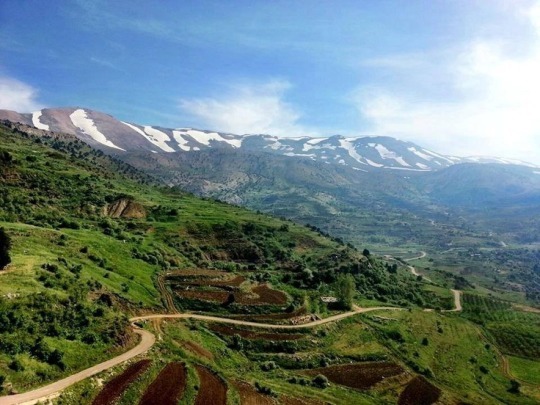
Lebanon is a member of the Arab League, la Francophonie, and the Organization of Islamic Cooperation.
Demographics
95% of the population is Arab, while Armenians make up 4%. The main religion is Islam, practiced by 55% of the population, 27.6% of which is Sunni.
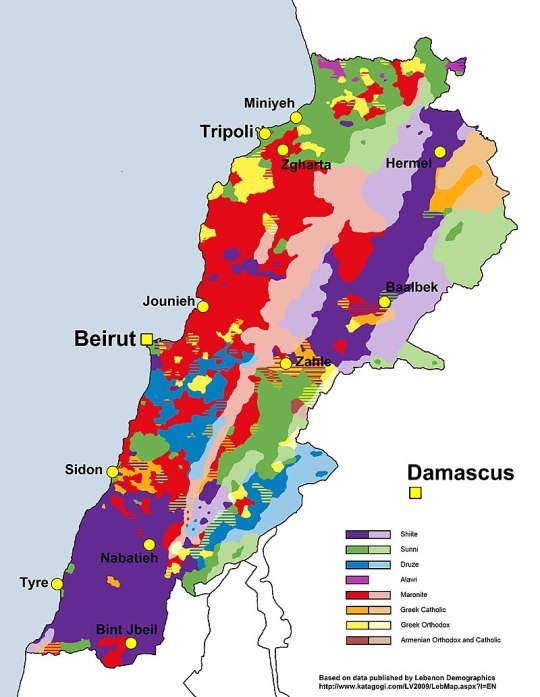
It has a negative net migration rate and a fertility rate of 1.7 children per woman. 89% of the population lives in urban areas. Life expectancy is 78.3 years and the median age is 31.3 years. The literacy rate is 96.7%.
Languages
The official language of the country is Arabic. French is spoken by 40% of the population.

Culture
Lebanese culture has Persian, Greek, Roman, Arab, Ottoman, and French influences. Lebanese people are very gregarious.
Men traditionally wear a shirt, a dark vest, baggy pants (sherwal), a belt, and a headdress. Women wear a shiny dress (gambaz), a wide belt, and a conical hat with a long piece of silk (tantur).
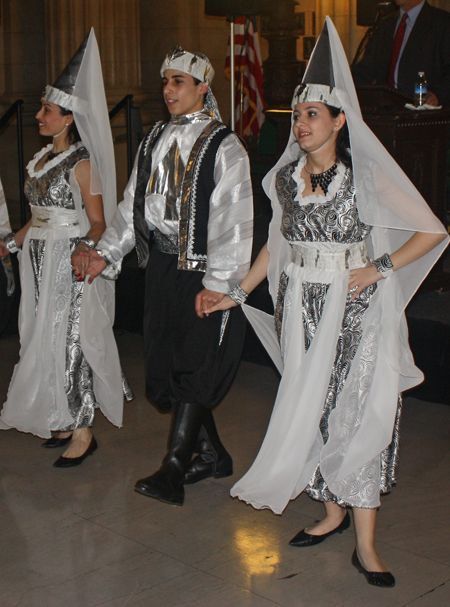
Architecture
Traditional houses in Lebanon are made of stone and wood and have flat roofs and terraces.
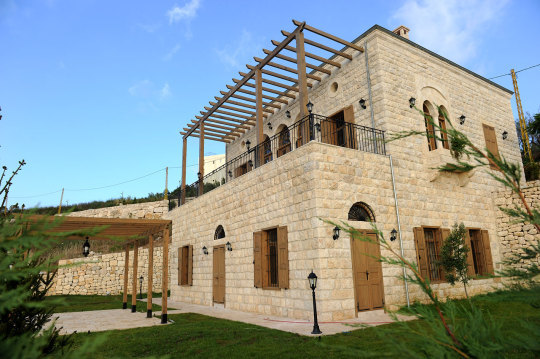
Cuisine
The Lebanese diet is based on fish, meat, pulses, and vegetables. Typical dishes include bamieh bi-zeit (okra and tomato stew), kibbeh (fried balls made of spiced meat and bulgur), sayadieh (seasoned fish and rice), sfouf (an almond-semolina cake), and tabbouleh (a salad of bulgur, onion, tomatoes, and parsley).
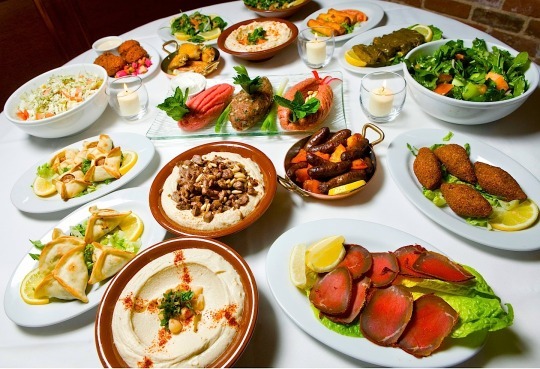
Holidays and festivals
Like other Christian and Muslim countries, Lebanon celebrates Epiphany, Armenian Christmas, St. Maroun Day, Feast of the Annunciation Day, Good Friday, Easter Sunday, Assumption, Christmas Day, Islamic New Year, Ashura, Mawlid, Eid al-Fitr, and Eid al-Adha. It also commemorates New Year’s Day and Labor Day.
Specific Lebanese holidays include Rafic Hariri Memorial Day on February 14, Liberation and Resistance Day on May 25, and Lebanese Independence Day on November 22.
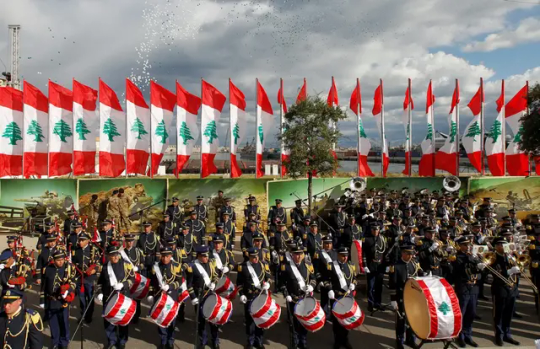
Independence Day
Other celebrations include the Aerial and Circus Arts Festival, the Baalbeck International Festival, which features dance and music performances, and the Beiteddine Art Festival.

Baalbeck International Festival
Landmarks
There are six UNESCO World Heritage Sites: Anjar, Baalbek, Byblos, Ouadi Qadish (the Holy Valley) and the Forest of the Cedars of God (Horsh Arz el-Rab), Rachid Karami International Fair-Tripoli, and Tyre.
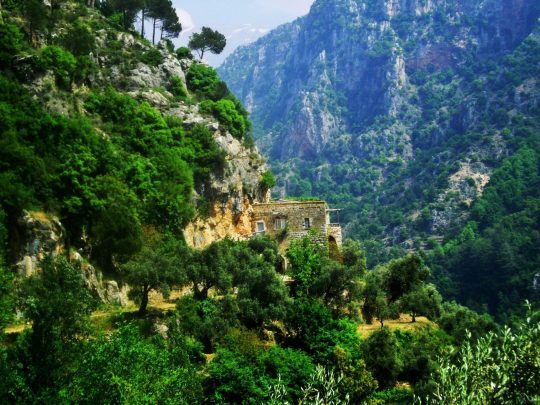
Ouadi Qadish and the Forest of the Cedars of God
Other landmarks include Jabal Moussa, the Mohammad Al-Amin Mosque, the Moussa Castle, Our Lady of Lebanon, and the Tripoli Citadel.
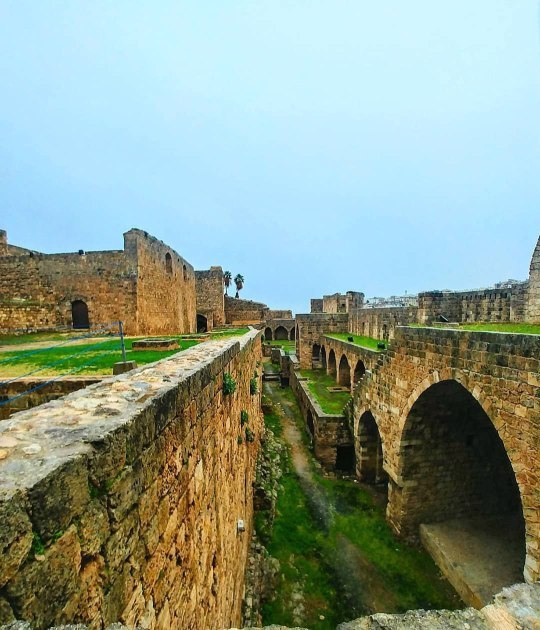
Tripoli Citadel
Famous people
Amin Maalouf - writer
Elie Saab - fashion designer
Fares Fares - actor
Jackie Chamoun - skier
Khalil Beschir - racing driver
May Ziade - poet and writer
Nadine Labaki - actress
Najwa Karam - singer
Ragheb Alama - singer
Rima Fakih - model

Rima Fakih
You can find out more about life in Lebanon in this post and this video.
6 notes
·
View notes
Text
@aesthetic-writer18
Part 1: a economic overview of Ancient greece
Greece had pretty poor soil. They relied heavily on agricultural trade for food and their economy was reliant on imported goods. They grew olives and grapes, which were complimented by herbs and vegetables. Husbandry was badly developed, consisting mostly of sheep and goats while bees were kept for honey, which was the only source of sugar known to the greeks.
Up to 80% of the Greek population was employed in the agricultural industry. Agricultural work followed the rhythm of the seasons: they harvested olives in autumn while trimming and keeping grapevines during the autumn seasons and the end of winter, while settings aside fallow land(land set aside so that it can recover nutrients) in the springs, harvesting cereals in summer and cutting wood, sowing seeds, and harvesting grapes into autumn, where the cycle would repeat. Greece had fairly mild but wet winters with hot and dry summers: typical of other mediterranean countries.Craftsmanship in greece was very much a big part of their domestic sphere(social circle), at least early on. Later around the 8th and 4th century BC(800 BC – 701 BC and 400 BC – 301 BC respectively), it moved to a more commercialized zone. Things like weaving and baking were done solely by women before the 5th century BC, before slaves were used after the expansion of commerce. Workshops were mostly family-operated and employed up until around 429 BC, following the death of Pericles, when a new class of wealthy owners and managers of workshops emerged.
Another aspect of greece’s economy was pottery. The greeks used the same method of pottery used since the bronze age. The potter's work consisted of selecting the clay, fashioning the vase, drying and painting and baking it, and then applying varnish. Part of production went to domestic use in things such as plates, containers, and lamps, commercial use for selling, and the rest served an artistic function. Pottery was often done by slaves and a few skilled artisans.
Greece practiced free trade, though later regulations were put in place to manage the trade of grains, flour, and bread. Maratime trade in greece was conducted by class of traders known as Emporoi. The state collected a duty(tax) on the cargo of Emporoi, which at Piraeus, the main port of Athens, was set to 1% or higher. One of the main drivers of trade in Ancient Greece was colonization. As larger city states set up colonies, there would be trade between the founding city and its colony. Furthermore, different climates in these colonies created a comparative advantage in goods.
The growing amount of trade in greece led to new financial techniques being developed. Most merchants lacked sufficient cash assets to fund their expeditions, and as a result, had to borrow money to finance part or sometimes all of their expeditions. A loan for a large venture in athens was generally a large sum of cash(usually less that 2000 drachmas, the greek currency of the time), lent for the duration of the voyage, which typically lasted several weeks or months, and had a high rate of interest. This interest rate was often set at 12% but could reach up to a 100% interest rate. These terms were always laid out in writing. The lender bore all of the risks; in exchange, the trader committed all of their cargo and fleet. These were often seized upon arrival to Piraeus as a precautionary measure.
Greece's main exports were olive oil, wine, pottery, honey, and metalwork. Imports included grains, pork, fine pottery, eels, and pulses from Sicily, Arabia, Egypt, Ancient Carthage, and the Bosporan Kingdom.
While peasants and artisans often sold their wares, there were also retail merchants known as kapeloi. They grouped into guilds and sold fish, olive oil, and vegetables. Women would sell perfume or ribbons, and merchants were required to pau a fee for their space in the marketplace. The general population viewed them poorly. Aristotle labled their activity "a kind of exchange which is justly censured, for it is unnatural, and a mode by which men gain from one another.”
Greece also apparently didn't directly tax their people. The Eisphora was a tax on the very wealthy, usually only levied in wartime. Particularly large fortunes were subject to liturgies: the support of public works. The Diaspora was another form of tax which only applied to the wealthiest. The citizens could reject the taxation, however, if they believed someone else was wealthier and not being taxed. The wealthier would have to pay for the liturgy. On the other hand, indirect taxes were quite important. Taxes were levied on houses, slaves, herds and flocks, wines, and hay, among other things.
Shopping centers in greece were known as Agoras. early in Greek history free-born citizens would gather in the agora for military duty or to hear statements of the ruling king or council. Every city had its agora where merchants could sell their products. Prices were rarely fixed, so bargaining was a common practice.
5 notes
·
View notes
Text
Greece: Economy
Greece had pretty poor soil. They relied heavily on agricultural trade for food and their economy was reliant on imported goods. They grew olives and grapes, which were complimented by herbs and vegetables. Husbandry was badly developed, consisting mostly of sheep and goats while bees were kept for honey, which was the only source of sugar known to the greeks.
Up to 80% of the Greek population was employed in the agricultural industry. Agricultural work followed the rhythm of the seasons: they harvested olives in autumn while trimming and keeping grapevines during the autumn seasons and the end of winter, while settings aside fallow land(land set aside so that it can recover nutrients) in the springs, harvesting cereals in summer and cutting wood, sowing seeds, and harvesting grapes into autumn, where the cycle would repeat. Greece had fairly mild but wet winters with hot and dry summers: typical of other mediterranean countries.Craftsmanship in greece was very much a big part of their domestic sphere(social circle), at least early on. Later around the 8th and 4th century BC(800 BC – 701 BC and 400 BC – 301 BC respectively), it moved to a more commercialized zone. Things like weaving and baking were done solely by women before the 5th century BC, before slaves were used after the expansion of commerce. Workshops were mostly family-operated and employed up until around 429 BC, following the death of Pericles, when a new class of wealthy owners and managers of workshops emerged.
Another aspect of greece’s economy was pottery. The greeks used the same method of pottery used since the bronze age. The potter's work consisted of selecting the clay, fashioning the vase, drying and painting and baking it, and then applying varnish. Part of production went to domestic use in things such as plates, containers, and lamps, commercial use for selling, and the rest served an artistic function. Pottery was often done by slaves and a few skilled artisans.
Greece practiced free trade, though later regulations were put in place to manage the trade of grains, flour, and bread. Maratime trade in greece was conducted by class of traders known as Emporoi. The state collected a duty(tax) on the cargo of Emporoi, which at Piraeus, the main port of Athens, was set to 1% or higher. One of the main drivers of trade in Ancient Greece was colonization. As larger city states set up colonies, there would be trade between the founding city and its colony. Furthermore, different climates in these colonies created a comparative advantage in goods.
The growing amount of trade in greece led to new financial techniques being developed. Most merchants lacked sufficient cash assets to fund their expeditions, and as a result, had to borrow money to finance part or sometimes all of their expeditions. A loan for a large venture in athens was generally a large sum of cash(usually less that 2000 drachmas, the greek currency of the time), lent for the duration of the voyage, which typically lasted several weeks or months, and had a high rate of interest. This interest rate was often set at 12% but could reach up to a 100% interest rate. These terms were always laid out in writing. The lender bore all of the risks; in exchange, the trader committed all of their cargo and fleet. These were often seized upon arrival to Piraeus as a precautionary measure.
Greece's main exports were olive oil, wine, pottery, honey, and metalwork. Imports included grains, pork, fine pottery, eels, and pulses from Sicily, Arabia, Egypt, Ancient Carthage, and the Bosporan Kingdom.
While peasants and artisans often sold their wares, there were also retail merchants known as kapeloi. They grouped into guilds and sold fish, olive oil, and vegetables. Women would sell perfume or ribbons, and merchants were required to pau a fee for their space in the marketplace. The general population viewed them poorly. Aristotle labled their activity "a kind of exchange which is justly censured, for it is unnatural, and a mode by which men gain from one another.”
Greece also apparently didn't directly tax their people. The Eisphora was a tax on the very wealthy, usually only levied in wartime. Particularly large fortunes were subject to liturgies: the support of public works. The Diaspora was another form of tax which only applied to the wealthiest. The citizens could reject the taxation, however, if they believed someone else was wealthier and not being taxed. The wealthier would have to pay for the liturgy. On the other hand, indirect taxes were quite important. Taxes were levied on houses, slaves, herds and flocks, wines, and hay, among other things.
Shopping centers in greece were known as Agoras. early in Greek history free-born citizens would gather in the agora for military duty or to hear statements of the ruling king or council. Every city had its agora where merchants could sell their products. Prices were rarely fixed, so bargaining was a common practice.
4 notes
·
View notes
Text
The Minty Marvel: Elevating Your Culinary Creations
Welcome to our culinary journey where we explore the wonders of mint! In this blog post, we're diving deep into the realm of the "Minty Marvel" and uncovering why it's an indispensable ingredient in the kitchen. Join us as we discover the history, flavor profile, and countless culinary uses of this versatile herb.
Mint's story begins in ancient civilizations where it was revered for both its medicinal properties and culinary allure. From the Egyptians to the Greeks and Romans, mint held a special place in culture and cuisine. Symbolizing hospitality and freshness, mint was used in rituals, remedies, and of course, in the kitchen. Its journey through history has left an indelible mark on culinary traditions worldwide.
Flavor Profile: Let's talk about that unmistakable flavor! Mint's cool, refreshing taste comes from menthol, a compound that not only tantalizes the taste buds but also offers a host of health benefits. Whether it's a subtle sweetness in a dessert or a zesty kick in a savory dish, mint's flavor profile is as versatile as it is delightful.
Culinary Uses: Now, let's get to the good stuff - how to use mint in your culinary creations! From beverages to desserts and everything in between, mint adds a burst of flavor and freshness to any dish. Need inspiration? How about a refreshing mint-infused lemonade on a hot summer day, or a fragrant mint pesto drizzled over grilled vegetables? The possibilities are endless, and the results are always delicious.
Growing and Storing Mint: Ready to take your mint obsession to the next level? Why not grow your own? Mint is a resilient herb that thrives in gardens or containers, making it perfect for both novice and experienced gardeners alike. With a few simple tips, you can have a steady supply of fresh mint at your fingertips. And when it comes to storing mint, we've got you covered. Learn how to keep your mint fresh for longer so you can enjoy its flavor whenever inspiration strikes.
For more information visit us:
0 notes
Text
CHEF ILONA: REVITALIZING GINGER CHICKEN NOODLE BOWL!
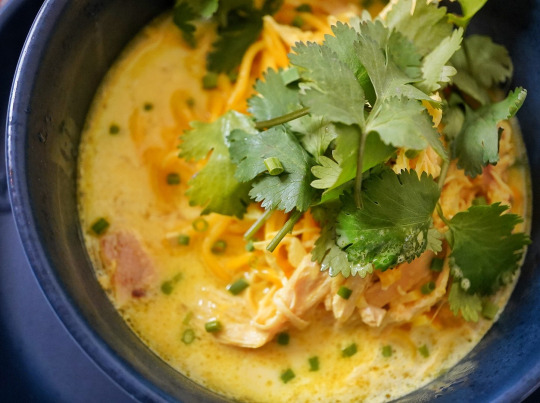
Ingredients that instantly remind me of sunshine and brightness are ones I often reach for in the darkest and shortest of days. Ginger and turmeric are at the top of my pure sunshine ingredients. The dazzling, indelible colour of turmeric conjures up memories of canola fields and a warm breeze blowing through my hair. Ginger brings vitality and vibrance to the tastebuds in such a singularly special way. Ginger is versatile, sliding easily into the role of sweet or savoury applications.

Ginger is a rhizome which means its root system grows and spreads across rather than vertically. These rhizomes of ginger are known as hands which is why you might sometimes hear the quantity of ginger needed for a recipe as “thumb-sized”.
Gingerol, the essential oil which gives ginger its unique aroma and flavour also has powerful anti-inflammatory and antioxidant effects which can help reduce nausea symptoms.

Additionally, ginger can soothe an upset stomach and can aid in more rapid digestion. Sometimes, if I’ve had a rich meal, I will slice a few thin slices of ginger, pop them into a mug, pour boiling water over them and sip like tea; it works like a charm.
Ginger was one of the first spices to have been exported from Asia. It made its way to Europe along with the rise of the spice trade and was used intensively by ancient Greeks and Romans as both medicine and flavouring.
The soup recipe I am sharing with you today is very approachable for a weekday meal. If you buy grocery store roasted chicken, the leftovers work well in this soup. If you want to make this soup plant-based, swap the chicken for some tofu sheets called yuba and some enoki mushrooms.

The pancit canton noodles are also a brilliant yellow which really sends that sunshine impact into overdrive. It is not entirely necessary to use the pancit canton noodles, you can use whatever you have on hand. I just adore the bright yellow noodles in the creamy golden broth. The fresh squeeze of lime and fresh cilantro are a must in my books. This soup is not suitable for freezing.
Revitalizing Ginger-Chicken Soup
Created by Chef Ilona Daniel
Serves 4
2 garlic cloves thinly sliced
2 Tbsp grated fresh ginger (fresh ginger is so important in this recipe)
1/4 teaspoon turmeric
4 Tbsp vegetable oil
4 cups Chicken Stock
1 can coconut milk
1 cup shredded cooked chicken
1 cup creamed corn (I use one of the smaller cans of creamed corn)
2 Tbsp Sriracha sauce for serving if desired.
Chopped fresh cilantro, thinly sliced green onion, and lemon wedges for serving
1 package (227g) Canton (Pancit Canton) noodles, cooked according to package instructions
In a stock pot, heat the oil to medium-high heat; quickly sauté the ginger, turmeric and garlic for about 20 seconds. Immediately pour in stock, coconut milk, and creamed corn. Simmer the soup for 15 minutes. Stir in noodles, shredded chicken, and heat through.
Serve with green onion, cilantro and lime.
#pei#chefilona#canadianchef#eastcoast#eater#cbcpei#chefsofinstagram#yum#explorecanada#foodwriter#FOODGASM#tastemaker#soupoftheday#noodlebowl
1 note
·
View note
Text
Liquid Soya Lecithin - Gujarat Ambuja Exports Limited

Liquid Soya Lecithin: The Quality Choice by Gujarat Ambuja Exports Limited
When it comes to Soya Lecithin, quality matters. Gujarat Ambuja Exports Limited takes pride in offering Liquid Soya Lecithin that meets the highest standards. Our Soya Lecithin is not just any product; it's Non-GMO and Kosher Certified, ensuring that it aligns with your values and dietary preferences.
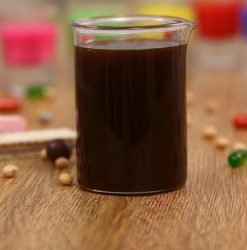
Soya Lecithin, crafted by GUJARAT AMBUJA, is a sophisticated blend of acetone insoluble phosphatides, primarily composed of phosphatidylcholine, phosphatidylethanolamine (PE), phosphatidylserine (PS), and phosphatidylinositol (PI). These essential components are combined with varying amounts of substances like triglycerides, fatty acids, and carbohydrates, meticulously separated from the crude vegetable oil source.
The term "Lecithin" finds its origins in the Greek word "lekithos – λεκιθος," which means egg yolk. This historical connection underscores the vital role Soya Lecithin plays in various applications, including food processing and pharmaceuticals.
Our commitment to quality extends to the very source of ourSoya Lecithin. It is derived from fresh gums during the de-gumming process of Soybean Oil, obtained from Non-GMO Soybean seeds. This ensures that you receive a product of uncompromising freshness and purity.
Choose Liquid Soya Lecithin from Gujarat Ambuja Exports Limitedfor your dietary and industrial needs. Embrace a product that is Non-GMO, Kosher Certified, and meticulously crafted to meet the demands of modern consumers. Trust in our commitment to quality, and experience the difference in your applications today.
For More Information
“Ambuja Tower”, Opp.Sindhu Bhavan, Sindhu Bhavan Road, Bodakdev, P.O. Thaltej Ahmedabad 380054.
[email protected](Export Inquiries)
[email protected](Investors Only)
+91-79-61556678
#export & import#manfacturing#Soya Lecithin#Acetone insoluble phosphatides#Phosphatidylcholine#Soya Lecithin import and Export#Soybean Oil#Soybean seeds.
0 notes
Text
Moringa Seeds With Wings
Our SVM Exports PKM1 quality seeds and manufacture organic moringa products from this tree produce. Moringa oleifera is a fascinating tree with its multiple applications for different purposes. Every part of this plant is used in variety of applications including agriculture, dye, food, health care, livestock forage, personal care, water purification and many more. Due to the easy adaptation to various regions, soils and farm systems, it holds consistent position in international market. It is a softwood tree, native to India, known as drought resistant and grows well even in moderately infertile soil. Moringa Oleifera is the best known species amount the thirteen species of the genus Moringacae. It was highly valued in the ancient civilizations. The Egyptians, Greeks and Romans derived oil from the seeds and used it for perfumes and skin care. In Indian sub-continent, people have used fresh pods and leaves as main vegetable food.
Botanical name:Moringa Oleifera
Contact Details:
SVM EXPORTS
Mob Number : 00 9487111111
WhatsApp:00 9442164111 [email protected]


#seeds#kernels#oil#nuts#drumstick#horserasish#dried herbs#herbs#organicherbsindia.com#moringaproductsindia.com
0 notes
Link
#Greek Fruit Exports#greek fruits export#greek vegetable exports#fruit exports Europe#order fruits from Greece#greek food exports#watermelon exports#fruit exports Greece#greek fruits#export company Greece#fruit exporters#fruit wholesalers#greek exports
2 notes
·
View notes
Link
#Greek Fruit Exports#greece fruit exports#greece vegetable exports#greek production#greek package#greek exports
0 notes
Text
Ev’s Homeland Lore
Trivia
Zadith - the country’s name might be a reference to Egyptian alchemist known in Latin as Senior Zadith. [tumblr likes to delete my external links but it’s on wiki]
Language - Zadithi, but demonym and adjective - Zadithian. No, I don’t know why
Cyrenice - the city’s name is created by combining names of two Ancient Greek and later Roman cities located in North Africa- Cyrene (modern day eastern Libya) and Berenice (modern day Egypt).
Some visuals are here.
Zadith
Zadith is a relatively large country bordered by the vast mountain ranges from the north to south-east and the sea on another side. It includes a dozen of islands (most of which are too small to be marked on the map below) off its south-western coast.

The population seems to concentrate in the western and southern areas, with the rest of the country’s territory being covered by Fenekh Desert and difficult terrain of highlands where human settlements are very sparse. Although the conditions there are harsh and not suitable for agriculture (except few oases), the area is rich in natural resources: with salt lakes and rich deposits of ores, such as gold, iron, copper, silver, as well as gems, limestone and marble.
Most of the south-west of the country benefits from the mild meditarenian climate with hot, dry summers and short and rainy winters. Wild olive trees are abundant, and large areas of oak and cyprus savanna provide pasture to the flocks and herds of the local farmers. Various fruit trees, almonds, grapes, wheat and barley are historically grown in the region.
The country has five main cities which also function as capitals of the provinces:
Zoar - the official capital of the country and its political centre which lies in a lush river valley;
Cyrenice - ancient seaside city and port known as academic and cultural centre;
Admah - remote mystic city on the step of the Clouded Mountains;
El-Kochab - eight angled star-shaped city hidden behind tall stone walls, home to the largest market in the country;
Tarut - capital of the island Thera and the biggest port on Zadithian islands.
Although it is not as multicultural as Vesuvia, Zadith was formed by the union of the formerly independent countries and later expanded further absorbing other city states and tribes, all being quite diverse culturally and ethnically. (Ev’s and Asra’s families have completely different backgrounds). The administrative regions of the country seem to broadly reflect those differences.
Zadithi is a common and official language, however the secondary native languages are still widely used in informal settings in certain areas.
The country is ruled by two equal Viziers (monarchs coming from two unrelated dynasties), each holding a veto over the other’s actions. The powers of Viziers are held in check by Ephors (form of parliament with 5 representatives of 5 provinces, the way those representatives are chosen varies by province). Each province is ruled by local governor and Zadithian history knows many instances in which the governors acted independently, and even in opposition to the rulers.
Zadith is considered a technologically advanced nation: there are complex irrigation and water supply systems, firearms are available to elite military, medicine is well developed, great strides have been made in the fields of chemistry and metallurgy. Due to the local conditions and farming not being predominant, the country is unable to export much of its agricultural produce (with exception to oil, cotton, linen). Zadith is most known for its luxury goods and crafts, such as fine fabrics, clocks, ceramics, spices, glassware, iron, jewelry and raw precious metals and gems. In many countries the word Zadithian is synonymous with innovative design and intricate craftsmanship. Zadith is also a well known place for headhunting when foreign nobility or royalty require teachers, scholars or any other skilled professionals.
Magic and mysticism are very common in Zadith: almost every household’s door has a protective charm on it and magical rituals are an essential part of the country’s festivals and celebrations. Magical creatures such as genies and phoenixes still live in the rural areas and some of them serve the most powerful magicians coming from Fenekh Desert and Clouded Mountains.
Both magic and science are highly respected in Zadith, but ‘intellectuals’ as a class still stand below nobility, religious leaders, who hold the political power in the country, and are not as wealthy as most of the merchants and landowners. Although knowledge and education is highly praised in Zadith, academic institutions are not that well developed. Most people study through private home tuition and apprenticeships. Popular and well developed academic disciplines as mathematics, physics, chemistry, geography, history and languages.
Zadith has complex currency and measurement systems, public holidays and customs vary by province which does not make trade with the country very straightforward. It is also known for not the most effective administration and tedious bureaucracy: if a foreigner wants to open business or pay taxes in Zadith, they are most inevitable going to go through at least 5 officials, fill in 15 forms and wait long time because the office that they need is either closed for the afternoon break (it’s hot country, they have siesta) or all the right people are off work celebrating something in their hometowns.
Cyrenice
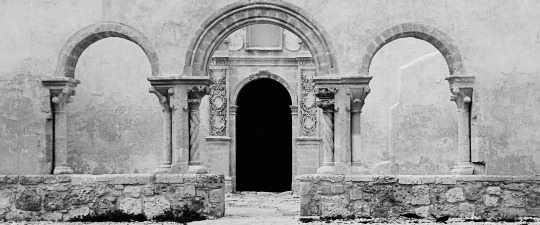
Pronounced as Ki-re-nay-is in Zadithi.
One of the oldest cities in Zadith, sometimes called the city of thousand statues: all built from the light coloured stone with a large commercial harbor overlooked by a walled tower. The city’s heart is the central district known as Agora which is the area of markets, public squares and plazas, where the people can formally assemble or gather for festivals, religious temples and shrines and the location of the main municipal buildings. Much smaller artistic and academic districts are also part of Agora. Residential districts are wrapped around the city centre from the north to south east. It looks like there is not much vegetation in the city with most of the gardens being hidden ininternal courtyards.
Cyrenice is known for holding many of the country’s artistic treasures and its vast ancient libraries which are open to the public. Throughout history those libraries attracted many scholars and academics, which allowed Cyrene to contribute to the intellectual life of the Zadithians, mostly through its famous historians, philosophers and mathematicians. One of the city’s attractions is the annual festival when the scholars finally leave the walls of the libraries and their faculties and compete in sports.
Alchemy

The concept of transmutation of base materials into noble metals is not central in Zadithian alchemy - they have plenty of gold without it. Alchemy is not focused on any particular type of science or magic, it is rather broad concept of combining both in various proportions: there are alchemists focused on medicine, physics, mechanics, chemistry, geology and astronomy and so on. Various enhanced crafting like creating magical items for practical use, also sometimes being considered as part of the alchemy.
It is not a new concept is Zadith and there is an ongoing debate on how it originated. Some say that alchemy was developed out of the practical necessity with magicians applying scientific principles to enhance their spells and scientists using magic to achieve faster results, some say it was purely academic discipline which found its practical application.
Much like scientists, alchemists are very proud and protective of their work. They use secret languages and codes to protect their research and notes and some are in the fierce competition with each other.
Alchemy is generally considered to be niche and complex discipline and there are way less alchemists than magicians.
#now the big question is why did I do write all of these#and how do I tag it#the arcana#evpanopolis#the arcana worldbuilding#fan apprentice#worldbuilding#disclaimer: this is intentionally vague and is not supposed to be a representation of any place or culture in the real world
55 notes
·
View notes
Text
Dionysus and the Devil
Some modern writers have suggested that memories of the cult of the Greek god Dionysus survived to influence the sabbath. There is no evidence of this, but there are several similarities between Dionysus and the Devil of the witches. Both appealed particularly to women and the rites of both were orgiastic. In animal form Dionysus sometimes appeared as a goat, though more often as a bull. At Eleutherai, the village from which his cult was exported to Athens, he was called Melanaigis, ‘he with the black goatskin’, and there was a ritual combat between ‘the Black One’ and ‘the Light One’, which suggests a parallel with the struggle between the Devil and God. At Delphi, Dionysus ruled the winter months and was apparently linked with the night sun or black sun, leading the dance of the stars, in contrast with the night sun or black sun, leading the dance of the stars, in contrast with the bright sun-god Apollo, who ruled the rest of the year. Dionysus was connected with the underworld, like other gods of fertility and vegetation, because plants and trees grow from beneath the surface of the ground.
- The Black Arts by Richard Cavendish
67 notes
·
View notes
Text
“...Cloth fibers could be dyed at several points during production (though again, note above that dyeing was far more common for wool than for linen). Assuming wool was scoured after shearing, it could be dyed at that point (thus the phrase ‘dyed in the wool’) though unscoured wool will not generally take a dye because the natural oils of the wool will prevent the dye from setting into the cloth. Alternately, wool might be spun and then dyed either as thread or as finished woven cloth. In the early modern period, undyed woven fabrics fit for dying were called ‘whites’ and might either be dyed locally or in some cases shipped significant distances to be dyed elsewhere (in no small part because, as we’ll see, the availability of dye colors was regionally dependent).
Today, we are used to the effectively infinite range of colors offered by synthetic dyes, but for pre-modern dye-workers, they were largely restricted to colors that could be produced from locally available or imported dyestuffs. If you wanted a given color of fabric, you needed to be able to find something in the natural world which, when broken down could give you a chemical pigment that you could transfer to your fabric in a durable way. That put real limits on the colors which could be dyed and the availability of those colors.
Some colors simply couldn’t be produced this way – a good example were golden or metallic colors. If something in a dress was to be truly golden (and not merely yellow), the only way to do that prior to synthetic dyes and paints was to use actual gold, weaving small strands of ultra-thin gold wire into the cloth or embroidering designs with it. Needless to say, that was something only done by the very wealthy. Alternately, if the dye for a given hue or color came from something rare or foreign or difficult to process (for instance, in all three cases, Tyrian or royal purple, which came from the murex sea snails – if you have ever wondered why no country has purple as a national color this is why, before synthetic dyes, coloring your flags and uniforms purple would have been bonkers expensive), then it was going to be expensive and rare and there just wasn’t much you could do about that.
What dyes were available thus varied based on where you were and how much you could afford to import. Determining ancient dye availability is often tricky, since fabric so rarely survives, but we know that the Romans prized a wide range of colors; Pliny gives us some clues as to some of the more expensive dyes in his Natural History (such as saffron for a rich yellow), along with more common colors like blue (from woad), red (from madder), brown (from walnuts), and a cheaper yellow from weld. Similar sets of dyes were available in the Middle Ages, J.S. Lee notes the principal dyestuffs in use in England were woad (blue), madder (red), weld (yellow), ‘grain’ red (scarlet, this is kermes dye), cinnabar (vermillion), saffron (yellow) and various other vegetable and fruit dies (op. cit. 62). Many of these were imported; madder and weld from Germany, France and the Baltic, kermes and woad from the Mediterranean, Cinnabar from the Red Sea area. Madder, weld and woad in particular were the cheapest and most common dyes and served as the foundation for clothing color in the ancient and medieval Mediterranean (which is, consequently, why colors that can be produced by those dyes, or by mixing them, are so common in medieval artwork depicting clothing).
Eventually (‘true’) indigo blue dye came all the way from India (it was known to the Greeks and the Romans) but because of its imported nature it was an expensive luxury product in Europe prior to European colonial expansion. Indigo is a particularly good example, however, of how a dye (and its associated color, the deep blue) could be relatively inexpensive and available in one place and a rare luxury good used as a status symbol in others. While the dyes available were somewhat restricted, dyers could of course combine pigments to get composite colors, giving a fairly wide range of colors, assuming one had the money for the pigments...
The actual dying process varied based on the pigment being used and there were likely local craft differences as well. Still the process could be complex, with dyestuffs often needing to be ground down or broken up and then often heated (sometimes boiled) in order to get the pigments ready before the cloth would be immersed in the dye.
...Other dyes might require a mordant, a fixing agent which enabled the pigment to set on the fibers of the fabric. Alum was often used; in the Middle Ages it was sourced from Asia Minor and so needed to reach Europe via Mediterranean trade (although Italian sources of alum were found in 1462; it was only produced domestically in England in the 17th century and after). In other cases, as with the use of dyes produced from wood, tannic acid might be used as the mordant. Each dye had its own unique preparation process to produce the dye; some involved boiling, others fermenting, some grinding down the products and so on. Dyers needed access to quite a lot of water, both for the processes of making dye, but also to discharge the various effluent from the process – spent dye mixtures and waste water. Once the dye was made, the fibers, which might be unspun wool, spun wool thread or woven wool cloth, were immersed in the dye and then agitated; the agitation was done with a ‘dyer’s posser’ and introducing or removing the cloth was done with tongs.
...Now it is necessary to caveat this upfront: in terms of raw amounts of cloth produced, household textile production is likely to have outstripped commercial textile production until the start of the industrial revolution, so while commercial textile production is more visible to us (in part because rich businesses tend to leave records and their owners tend to be the sort of people to be literate and write things like wills which we can read) they weren’t the majority of production. So while clothiers and cloth merchants and professional weavers often get more attention in the sources (and consequently may get more attention in some modern treatments) they were likely a minority of cloth workers and cloth production prior to the early modern period.
At the same time, it is clearly wrong to think of the household production chain as being completely divorced from the commercial production chain; the two were clearly intermingled. Fullers and dyers seem to have represented a point where the two production systems converged; fulling and dying were difficult to do at household scale and required special skills and so it seems that even a household producing its own textiles would have a use for the fuller and the dyer to finish those clothes (because, again, people liked to look nice). Moreover, as we’ve discussed already, commercial clothiers often sourced the spinning and weaving they needed through the putting out system, paying domestic spinners and weavers (mainly women) on a wage or piece-work basis (that is, per-unit of thread or fabric).
...But of course there were also purely commercial workers making cloth, including elements of production that couldn’t be brought into the household (like fulling and dyeing) but also producers who worked primarily for the market. The emergence of large-scale textile production for markets – what we might term commercial production – seems closely connected to the rise of large cities, presumably because those cities contained both elites who might want to buy more (or finer) fabrics than their household could produce as well as poorer workers whose households (which might just be themselves) lacked the ability to produce textiles at all. Long distance trade was also clearly a factor that drove the emergence of large-scale cloth production; wool products were major exports as early as third millennium BC Summer (on this, note several of the chapters in C. Breniquet and C. Michel, op. cit.)
In both cases, we can see that dyers tend to be rather more highly paid than other textile workers, while second place goes to fullers (in the second chart, note that fulling, cleansing and finishing were all done in a fullery; it is the last task, I think, that would be done by the fuller himself (or herself) rather than paid workers or – in the Roman context – enslaved workers), with skilled professional weavers in the third place. The range of tax paid though gives a real sense of how there might be a considerable separation between the earning power of small-scale producers (or apprentices and other hired workers in a larger operation) and producers working at a larger scale (or making elite products).
Dyeworks (and fulleries in the medieval period) tended to be located just outside of urban centers, in part because of the smell (both kinds of work tend to smell quite bad). Because both dyeing and fulling made use of bad smelling mixtures, older scholars often assumed that the workers in these occupations were low status individuals and looked down upon. And while it is true that there does seem to have been some sense that these places were not terribly sanitary, more recent scholarship tends to show little evidence that the people who worked there – particularly the skilled, professional dyers and fullers – were low-status themselves.
In terms of the social position of cloth-makers, one indicator we can look to is professional associations and guilds. In the Roman world, professional associations (collegia) of fullers seem to have been quite common and Miko Flohr (op. cit.) argues persuasively that Roman fullers were respectable professionals, similar to other artisans – well below the political and social elite (whose wealth was in large landholdings), but not disreputable. Fuller’s collegia could be significant politically though; Flohr notes that Roman fullers seem to have been politically active, for instance, in Pompeii’s local politics (most famously dedicating a statue of Eumachia, a local aristocratic woman, outside of the ‘building of Eumachia’ the purpose of which is still under some dispute (but perhaps a market-place for fabric?)).
...So while the landed elite will have looked down their nose as textile workers (they looked down their nose at everyone), skilled professional textile workers represented fixtures in what we might see as a lower-middle-class of sorts in pre-modern cities. Because there were so many of them (and because they were attached to cloth merchants who might be truly wealthy) they often exerted a significant political and cultural pull. Thus there is an enormous range in the status of cloth-workers, from the well-to-do dyer who might be a respected professional artisan to the poorly paid spinner working in the ‘putting out’ system in her spare time when she wasn’t making clothing for her relatively poor farming family.”
- Bret Devereaux, “Clothing, How Did They Make It? Part IVa: Dyed in the Wool.”
3 notes
·
View notes
Link
Prime Minister of the State of Israel: I have tears in my eyes, really touching 😔😥😥✊
Mr. Nethanyahu said:
Only 70 years ago! the Jews were led to the slaughterhouse like sheep.
> Only 60 years ago!
> No country. No army.
Seven Arab countries declared war on the small Jewish state, only a few hours after its creation!
> We were 650,000 Jews against the rest of the Arab world!
No IDF (Defense Force of Israel).
No powerful Air Force, only brave people with nowhere to go.
> Lebanon, Syria, Iraq, Jordan, Egypt, Libya, Saudi Arabia
> attacked all at the same time.
> The country the UN "gave us" was 65% desert.
> The country came out of nowhere!
> 35 years ago! We fought the three most
> powerful from the Middle East, and we wiped them out in six days.
We have fought against different coalitions of Arab countries, which had modern armies and many Soviet weapons, and we have always fought them!
Today, we have :
> A country,
> An army,
> A powerful Air Force,
> A state-of-the-art economy that exports millions of dollars.
> Intel - Microsoft - IBM is developing products here.
> Our doctors win awards for their research in the medical field.
> We make the desert bloom, and sell oranges, flowers and vegetables to the whole world.
> Israel has sent its own satellites into space!
> Three satellites at the same time!
> We are proud to be on the same level as:
> The United States, which has 250 million inhabitants,
> Russia, which has 200 million inhabitants,
> China, which has 1.3 billion inhabitants;
> Europeans - France, Great Britain, Germany - who have 350 million inhabitants.
> The only countries in the world to send objects into space!
> Israel is now part of the family of nuclear powers,
> With the United States, Russia, China, India, France, and
> Great Britain.
> (We never admitted it officially, but everyone knows it)
> And to think that only 60 years ago,
> We were led, ashamed, without hope, to the massacre!
> We got out of the smoking ruins of Europe,
> We won our wars here with less than nothing
> We built our little "empire" from nothing.
Who is Hamas to scare me?
> To terrify me?
> You make me laugh!
> Passover ’was celebrated;
> Let’s not forget what it’s about.
> We survived Pharaoh,
> We survived the Greeks,
> We survived the Romans,
> We survived the Inquisition in Spain,
> We have pogroms in Russia,
> We survived Hitler,
> We survived the Germans,
> We survived the Holocaust,
> We survived against the armies of seven Arab countries,
> We survived Saddam.
> We will also survive the enemies present
Think of any time in human history!
Think about it, for us, the Jewish people,
> The situation has never been better!
> So let's face the world,
We recall :
> All nations or cultures
> Who one day wanted to destroy us,
> No longer exist today - while we still live!
> Egypt?
> The Greeks?
> Alexander of Macedonia?
> The Romans? (Does anyone still speak Latin today?)
> The third Reich?
> And look at us,
> The nation of the Bible,
> The slaves of Egypt,
> We are still here,
And we speak the same language!
> Here, and now!
> The Arabs don't know it yet,
> But they will learn that there is a God.
> As long as we keep our identity, we are eternal.
So excuse us for not worrying,
> Not to cry,
> Not to be afraid.
> Things are going well here.
> They could certainly get better,
However:
> Don't believe the media,
> They don't tell you the truth
> Let the holidays continue to take place,
> Let people continue to live,
> Let people keep going out,
> Let people continue to see friends.
Yes, our morale is low.
> So what?
It is only because we mourn our dead while others rejoice at the bloodshed.
> This is why we will win, in the end.
NEVER SLEEP OR SLEEP THE GUARDIAN OF ISRAEL!
Forward this SPEECH to the whole community,
SHARE ON YOUR WALLS WITH YOUR FRIENDS🙂🙏
17 notes
·
View notes
Photo

Plastic greenhouses cover a stretch of shoreline on the south coast of Crete — the largest and most populous of the Greek islands. Inside these greenhouses, which cover an area of roughly 6 square miles (15 sq. km), large quantities of fruits and vegetables are grown for export. In the upper right corner of this Overview is the Bramiana Reservoir, which was built in 1986 to meet the needs of the thousands of greenhouses surrounding it.
Instagram: https://bit.ly/2FcI9Ce
35°01'45.4"N, 25°41'46.0"E
Source imagery: DigitalGlobe
152 notes
·
View notes
Text
When are we going to acknowledge that plenty of African food staples are already vegan (AND gluten free)?
With dairy not being the most ancient food staple for *most* tropical and savannah Africans, plenty of various African food staples are already vegan because of that fact. Everything from gari to fufu to injera to tiger nut milk to agundai fitfit and shiro to jollof rice and chapatis... those plus dishes from Africa's diasporic cuisine in the West Indies and Latin America.... are absolutely RIFE with already vegan and gluten free options and here are some of the obvious reasons:
1. The abundance and ubiquity of starches in warm environments. Starches are filling, swell and carry water, and are abundant in warm hot climates and easy to prepare and store for long journeys too. Yams, non-European grains (millet, sorghum, teff, kamut) and other starchy vegetables, tubers, fruit and grains are super-staples that are curiously missing from the superfoods hype list despite their nutrition and accessible pricing. Just 3.5oz of millet contains 11 grams of protein. It prevents diabetes, lowers triglycerides, is packed with vitamin B6 and Manganese too. It's gluten free just like teff. These are affordable grains.
2. Spices gone wild! Spices make vegetables and savory fruits very very agreeable to the palate, resulting in simple dishes like collard greens or calaloo with nightshades being jam-packed with flavor, making it easy to forget that you're just eating leaves. You would think that with the abundance of spices and flavors that appeal to most tastes, these diverse cuisines would be hyped up.
There seems to be a food hierarchy that literally pushes the media-fed lie that certain people groups don't eat and have nothing to contribute to veganism and thus need to be "saved" by veganism. This ignorance bolsters the fallacious idea that veganism and food in general must be handed out or "taught" to them, which actually continues and validates the current colonial capitalist order that veganism is tiptoeing around with its shortsighted activism.
3. Lack of (or relatively late) non-human Animal Slavery. Due to a lack of total reliance on domestic bovids, many (but not all, I repeat, not all) African countries and cultures do not prioritize dairy, (with many many exceptions of course). Dairy is not exactly a base in most African cuisine. That includes the areas close to Mediterranean Europe (even nearby Greek and Italian food have plenty of dairy free options). Camels and dairy cows were not always present on the continent. They were actually introduced, so you'll find that a lot of very ancient dishes are dairy free. Nigeria actually has been drinking nut milk (tiger nut milk, coconut milk etc) for centuries! Why aren't vegans talking about this? The world NEEDS to know that nut milk is neither new nor unusual to human beings.
Mainstream veganism tends to fetishize Asian food in the same way Asian women are fetishized, and this hyping up of third world Asian countries for rich western vegans also has a problematic angle, because those same places (Thailand etc) have a big sex tourism industry as well as rampant rape culture that I am afraid is being swept under the rug due to it not happening to non human animals. See the whole Durianrider controversies....
This "ripe for the picking" attitude amongst elite vegans is eerily similar to the colonizer mindset. We do not, as vegans, need to fetishize one or two regions unsustainably. Central America and Southeast Asia are not to be plundered. Please spread out your interests and boost other economies too. Vegans should be first in line NOT to over-harvest specific regions of the world where indigenous folk are being pressured. Africa's economies are ripe for support and desperately need to EXPORT and make some money rather than be forced to import poisonous American food that wipes out local, native economies.
So next time you go to a small grocery store, pick up a box or bag of fufu, gari, cassava flour or groundnuts from an authentic, African brand. Let's show some support to these untapped markets and help introduce the world at large to the vegan foods so many people have been sleeping on for ages. Please try to promote accessible, affordable vegan food. Not every meal has to include avocados or açai berries. Sometimes the humble plantain is enough.
#vegan for the environment#vegan for the animals#animal identity vegan#veganism#vegan#afrovegan#decolonize#decolonize your diet#accidentally vegan#vegan african#caribbean vegan#vegano latino#vegano#fufu#gari#history of nut milk#nut milk#tiger nut milk#african gluten free#ethnic vegan
50 notes
·
View notes
Text
Discovering the world
Malaysia 🇲🇾
Basic facts
Official name: Malaysia
Capital city: Kuala Lumpur
Population: 34.3 million (2023)
Demonym: Malaysian
Type of government: federal parliamentary constitutional monarchy
Head of state: Ibrahim Iskandar (Monarch)
Head of government: Anwar Ibrahim (Prime Minister)
Gross domestic product (purchasing power parity): $1.3 trillion (2024)
Gini coefficient of wealth inequality: 40.7% (medium) (2021)
Human Development Index: 0.807 (very high) (2022)
Currency: ringgit (MYR)
Fun fact: It has the biggest roundabout in the world.
Etymology
The country’s name is a combination of the word “Malay” and the Latin-Greek suffix -ia, so it can be translated as “land of the Malays”.
Geography
Malaysia is located in Southeast Asia and borders Thailand and Brunei to the north and Indonesia to the south.

There are two main climates: tropical monsoon in the northwest and tropical rainforest in the rest. Temperatures range from 21 °C (69.8 °F) in winter to 33 °C (91.4 °F) in summer. The average annual temperature is 27 °C (80.6 °F).

The country is divided into thirteen states (negeri) and three federal territories (wilayah persekutuan). The largest cities in Malaysia are Kuala Lumpur, Kajang, Seberang Perai, Subang Jaya, and Klang.

History
2nd century-1026: Gangga Negara
200s-1500s: Langkasuka
330-1821, 1842-present: Sultanate of Kedah
449-1454: Old Pahang Kingdom
671-692, 1028-1347: Melayu Kingdom
671-1025: Srivijaya
848-1279: Chola Empire
1293-1527: Majapahit
1351-1767: Ayutthaya Kingdom
1363-1888: Sultanate of Brunei
1400-1528: Malacca Sultanate
1400-1902: Sultanate of Patani
1457-1915: Sultanate of Sulu
1470-1623: Pahang Sultanate
1496-1903: Kingdom of Aceh Darussalam
1509-1641: Malay-Portuguese conflicts
1511-1641: Portuguese Malacca
1528-1855, 1886-present: Johor Sultanate
1599-1641: Sultanate of Sarawak
1641-1795, 1818-1825: Governorate of Malacca
1770-1881: Pahang Kingdom
1821: Siamese invasion
1826-1946: British Malaya
1841-1946: Raj of Sarawak
1941-1945: Japanese occupation
1946-1948: Malayan Union
1946-1957: Crown Colony of Malacca; Crown Colony of Penang
1946-1963: Crown Colony of North Borneo; Crown Colony of Sarawak
1948-1960: Malayan Emergency
1948-1963: Federation of Malaysia
1963-present: Malaysia
1968-1989: Communist insurgency
1969: 13 May incident
2020-2022: political crisis
Economy
Malaysia mainly imports from and exports to China, Singapore, and the United States. Its top exports are palm oil, electronic circuits, and refined oil.
It has natural gas, oil, and tin reserves. Services represent 58.6% of the GDP, followed by industry (24%) and agriculture (6.3%).

Malaysia is a member of the Asia-Pacific Economic Cooperation, the Association of Southeast Asian Nations, and the Organization of Islamic Cooperation.
Demographics
Malays account for 57.3% of the population, while Chinese people represent 22.9%, indigenous peoples 12.4%, and Indians 6.6%. The state religion is Islam, practiced by 63.5% of the population, almost all of which are Sunni.

It has a positive net migration rate and a fertility rate of 1.7 children per woman. 74.7% of the population lives in urban areas. Life expectancy is 76.1 years and the median age is 29.5 years. The literacy rate is 88.7%.
Languages
The official language of the country is Malay, but English is an official language of institutions in two states.

Culture
Malaysian culture has Arabic, British, Chinese, Indian, and Persian influences. Malaysia is one of the most tolerant countries in Asia due to its multiethnic society.
Men traditionally wear a long-sleeved shirt (baju), pants (celana), a skirt-type adornment (samping), and a cap (songkok). Women wear a knee-length blouse (baju) and a long skirt (sarong).

Architecture
Traditional houses in Malaysia are placed on stilts, made of wood, and have tile roofs.

Cuisine
The Malaysian diet is based on fish, meat, rice, and vegetables. Typical dishes include gulai (curry stew with fish or meat and vegetables), kebebe (a salad with bamboo, chili peppers, fruit, and shrimp paste), kek batik (a cake made of butter, chocolate powder, cookies, eggs, and condensed milk), mee bandung (noodles with chilies, egg, onion, and dried shrimps), and nasi lemak (rice cooked in coconut milk and served with anchovies, chili paste, and cucumber).

Holidays and festivals
Like other Buddhist, Christmas, Hindu, and Muslim countries, Malaysia celebrates Buddha Day, Christmas Day, Diwali, Mawlid, Revelation of the Quran, Eid al-Fitr, Eid al-Adha, and Islamic New Year. It also commemorates New Year’s Day, Chinese New Year and Labor Day.
Specific Malaysian holidays include King’s Birthday on the first Monday of June, Independence Day on August 31, and Malaysia Day on September 16.

Malaysia Day
Other celebrations include the Malaysia Water Festival, which features a fishing tournament, kayaking, and sandcastles; the Taday Ka’amatan Harvest Festival, where there are arm-wrestling and blowpipe shooting competitions, and Thaipusam, a Tamil festival with a grand procession.

Thaipusam
Landmarks
There are five UNESCO World Heritage Sites: Archeological Heritage of Niah National Park’s Caves Complex, Archeological Heritage of the Lenggong Valley, Gunung Mulu National Park, Kinabalu Park, and Melaka and George Town, Historic Cities of the Straits of Malacca.

Gunung Mulu National Park
Other landmarks include the Batu Caves, the Kota Kinabalu City Mosque, the Petronas Twin Towers, the Taman Negara National Park, and the Thean Hou Temple.

Thean Hou Temple
Famous people
Abdul Samad bin Muhamad Samad - poet and writer
Bernice Chauly - artist and writer
Henry Golding - actor
Jimmy Choo - fashion designer
Lee Chong Wei - badminton player
Michelle Yeoh - actress
Nicol David - squash player
Nigel Ng - comedian
Poh Ling Yeow - chef
Siti Nurhaliza - singer

Nigel Ng
You can find out more about life in Malawi in this article and this video.
12 notes
·
View notes